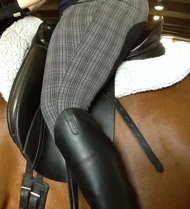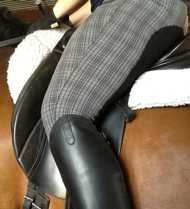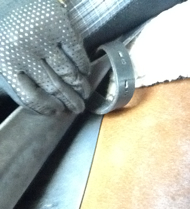
Riders:
Adjusting your stirrups once mounted While there are ways to figure out
if your stirrups will be the correct length even
before you get on, you'll never really know if
they're right until you've mounted. If they're the right length, hooray!
If not, you'll either need to dismount and
readjust them, or you can shorten or lengthen them
while you're still on your horse. It makes sense
to adjust them while you're mounted, because
you'll know immediately if you've gotten them to
the right length. But there's a right (safe) way, and
several wrong (unsafe) ways to adjust your
stirrups. Learn to do it the safe way, and live to
ride another day! The wrong way:
"But Karen," I hear you saying,
"I've used one of the methods above and I've never
had any problem ever ever ever." Lucky you! And I've never been in a
car accident, and yet I fasten my seat belt every
time I get in a car. Practicing safe methods is a
good idea even if you ride the most bombproof
horse -- you never know when a passing car will
backfire, or a plastic bag blow across the ring,
or a cat jump out of the rafters, or when a tiny
meteorite from the far reaches of outer space will
hit the roof of the arena and spook the living
daylights out of your horse. You just don't know.
And for that reason, it's worth it to always be
safe. The right way: "But Karen," I hear you say again,
"adjusting my stirrups the way you want is hard
(haaaaa-aaaaaard). I'm not good at it!" Yep. All new skills are hard to
begin with. Stop whining. Practice. Get better.
Put your reins (and whip, if you're
carrying one) in one hand, and lean that hand on
the horse's neck if you need help with your
balance. With your free hand, reach in front of
your thigh, grasp the stirrup leather by the
buckle, and pull the buckle away from the stirrup
bar. You'll feel like you're doing a little bit of
"legs away" exercise, but your leg will remain in
more-or-less the correct riding position. You
won't surprise your horse with your leg in an
unusual position. Using your hand, aided by your foot
in the stirrup (step on the stirrup to pull the
leather through the buckle), adjust the stirrup
leather to the correct length, testing as you go. Once you've adjusted one stirrup
leather, repeat the process with the other.
Remember to switch your whip to the other side so
it stays out of your way.
If your stirrups leathers are long,
you'll have a long "tail" flapping around behind
the saddle. It's a shame to trim the leather --
the next person to use the saddle might need
longer leathers. But that flapping tail might annoy
your horse. If that's the case, it's easy to tuck
in the tail between the saddle flap and sweat
(under) flap.
Oh, and here's a nice website by a
professional saddler, with English saddle
terminology, so you can always sound like an
expert! Saddle
fitting: The inside journey: Parts of the
saddle, terminology Thanks to Bailey McCallum and Antares (Annie) for being my models for this project. |
|
|
| Copyright 1996-2014, Karen Pautz. All rights reserved. |

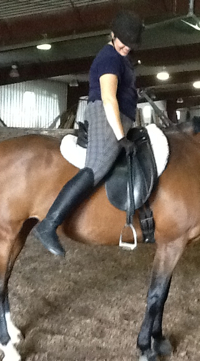

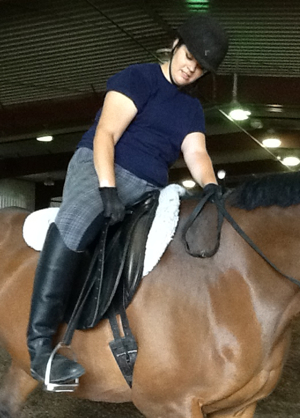 The
safest way to adjust your stirrups once mounted is
to keep your foot in the stirrup. With
your feet in the stirrups, you're ready for any
emergency.
The
safest way to adjust your stirrups once mounted is
to keep your foot in the stirrup. With
your feet in the stirrups, you're ready for any
emergency.